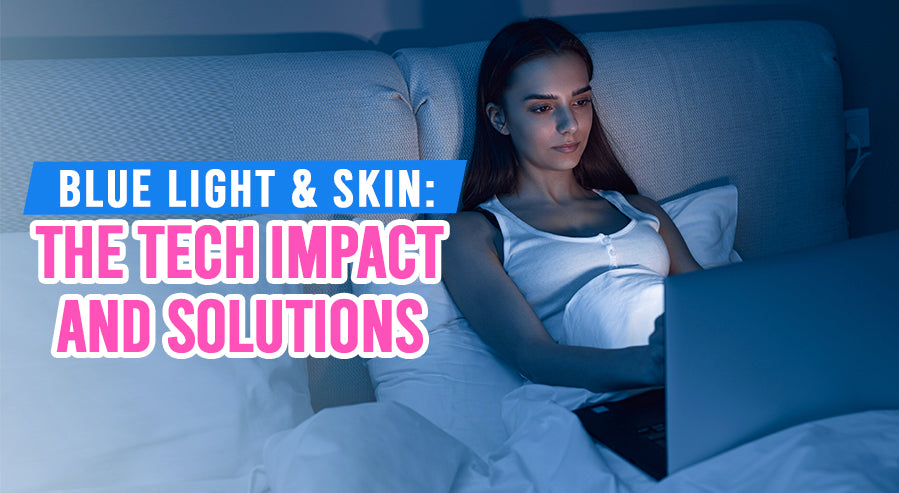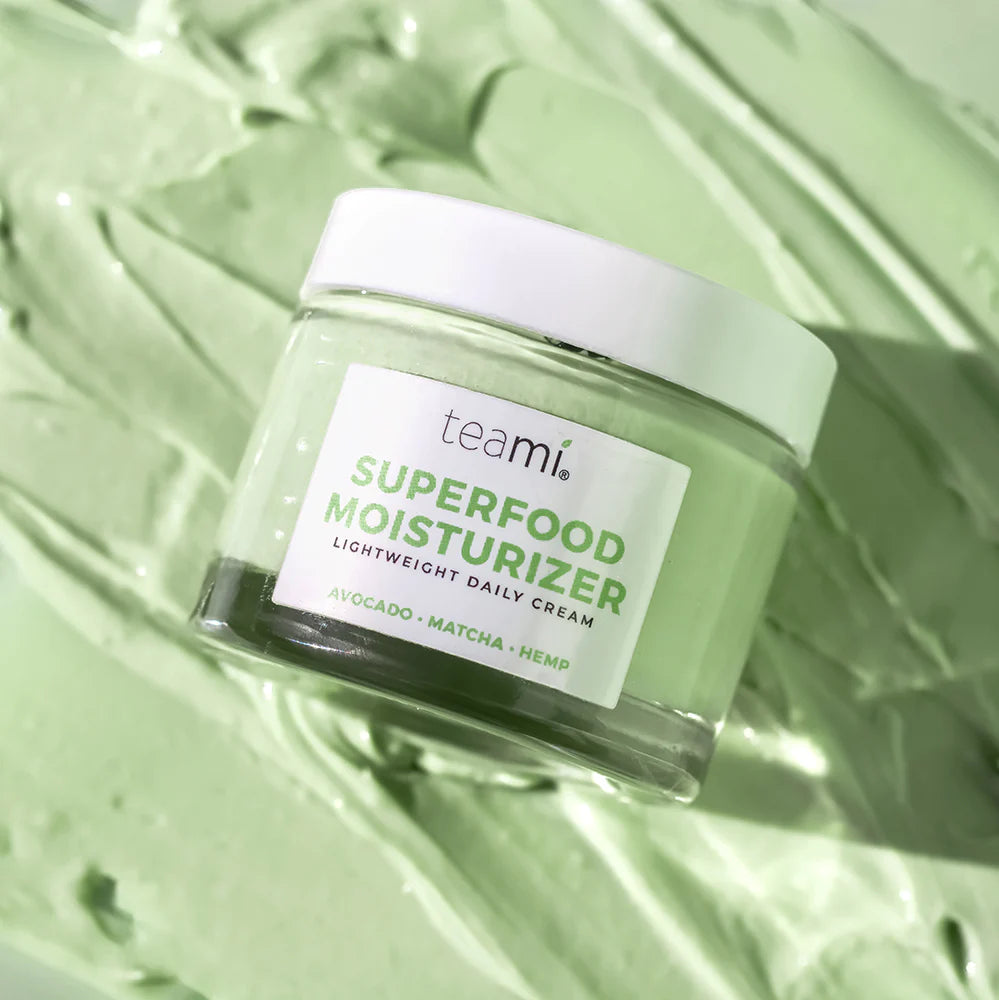Blue Light & Skin: The Tech Impact and Solutions

Technology is one of the most amazing things humanity has created due largely to the avenues it has opened for us. Once upon a time, we had to spend hours reading books in isolation to research the knowledge we needed. While such research was worth the effort, it was a time-consuming process for which many modern individuals might not have the time.
Fortunately, the creation of the Internet and the devices through which we access it have enabled us to access information instantaneously. The collection of knowledge we tirelessly studied is now archived online for rapid perusal, alongside tools that make it easier to access specific snippets of data. In addition to information, most sources of entertainment and resources for professional tasks are available on computers and phones.
Unfortunately, our reliance on screens has exposed us to a new hazard that can affect our skin and eyes.
The glow of a computer screen is not quite what it appears to be since our perception of light is extremely complex. We perceive light on a spectrum of colors and wavelengths with different intensities. Some are gentle enough that we can spend hours around them without much risk, whereas others are harsh and intense enough to cause permanent damage.
The light cast by a computer monitor or phone screen has multiple wavelengths that range from gentle to harsh. Blue light is one of the harsher wavelengths projected by technology screens, which is common to virtually all devices. Blue light can cause significant damage, and protecting against it is extremely difficult but not impossible.
What is Blue Light?
Anyone who has not looked into light wavelengths might assume that blue light is a self-explanatory term. Unfortunately, these wavelengths are extremely complex and harder to understand than expected. The term "blue light" is not literal but refers to a wavelength of perceptible light that does not produce an observable hue. In the strictest sense, blue light is blue, but only in the context of the wavelengths perceptible to the human eye.
The wavelength perceptible to us includes light 380 nanometers long (violet light) to 700 nanometers long (red light). All the colors we have names for are on that spectrum, with red light leading into orange, yellow, green, and so on. We can perceive these colors thanks to a series of photoreceptor cells that contain rods and cones. These cells are found in our eyes and are directly responsible for our ability to perceive the wavelengths of light that produce colors.

Because we all have different genetics, some people have different rod and cone concentrations, making them more sensitive to certain wavelengths. The biggest distinction is determined by biological sex since women perceive warmer wavelengths and men perceive wavelengths with poor contrast.
However, our sensitivity to blue or red light can vary by person and cause some people to perceive certain colors differently from their friends. For example, one person might see a bright red while their friend sees a darker shade. Regardless of personal perception, some wavelengths are inherently harsher on the eyes than others. An important detail is that the shorter the wavelength is, the brighter it is, with lights from the 100 to 380 nanometer range accounting for ultraviolet light.
Blue light falls under the high-energy visible (HEV) light spectrum, making it extremely bright compared to the other perceptible wavelengths. Blue light is second only to ultraviolet light, and extended periods spent looking into blue light can cause damage to our eyes. Furthermore, constant exposure to blue light can cause skin damage, though not as intensely as ultraviolet light. We can protect our skin and eyes from ultraviolet light, but not everyone knows we can do the same when exposed to blue light. The only question is: How do we protect against the blue light cast by our devices?
Can Blue Light Damage Skin?
Before we discuss protection, it is important to understand the risks posed by blue light so we know why we need to protect ourselves. Despite being classified differently from sunlight, blue light is an intense type of light that can damage our bodies if we spend too much time in it. Unfortunately, most modern professionals spend hours in front of a computer.
The extended time we spend in front of a screen makes it significantly more likely that we will suffer the ill effects of blue light. The problem is that not everyone recognizes what those ill effects entail and how they can impact our health and appearance. Remember that HEV light is extremely similar to UV light, which exposes the skin to molecules called free radicals.
In high enough concentrations, these molecules damage our skin on a cellular level and induce cosmetic and health issues. One of the main points of overlap between HEV and UV light is that both can cause photoaging.
Photoaging is a phenomenon in which our skin seems to age beyond its years due to exposure to certain elements. This happens because blue light causes the skin cells to shrink and die way before their time, which induces symptoms associated with aging. Excessive exposure to blue light can cause us to develop wrinkles and age lines, making us look older.

Furthermore, exposure to blue light can cause pigment changes that make patches of skin darker than the rest of our complexion. This issue was primarily linked to individuals with naturally dark skin tones, but it can affect anyone who spends a long time exposed to blue light. The scary part is that it only takes 60 minutes for the effects of blue light to impact your skin.
Ironically, blue light is also used to help the skin. When controlled properly, small doses of blue light can heal the skin and reduce the symptoms of certain skin conditions. One of the main uses of blue light in skin care is to reduce the effects of mild to moderate acne.
Blue light has been found to reduce the number of blackheads, whiteheads, and other acne within a week. Nevertheless, these treatments can backfire if you use them too often and will usually cause the skin problems mentioned above. The worst part is that skin damage is the least of blue light's risks.
Can Blue Light Damage the Eyes?
The most dangerous risk associated with blue light is that it can damage our eyes, which you no doubt know are responsible for our vision. While there are plenty of blind individuals who are completely capable, losing sight in the middle of your life can be devastating. It requires you to change your entire method of living since you must adapt to life without one of the most commonly used senses we have.
The effect blue light has on our eyes is essentially a weaker version of what happens if we were to stare into the sun. The ultraviolet light cast by the sun is the brightest perceptible form of light known to us, but blue light is a close second. Despite that, blue light is significantly weaker and takes longer to cause lasting damage to our eyes. The main reason blue light is so dangerous is because of how we act when we are in front of a screen. Research has shown that people who regularly use digital devices blink less when actively using them.
Next time you sit in front of your laptop, try to count how many times you blink. You might be surprised at how small the number is. Failing to blink regularly prevents our eyes from receiving the moisture they need to stay hydrated and healthy. As a result, we develop digital eyestrain, and the cones and rods in our eyes become more sensitive to intense light.

You might notice symptoms such as:
- Dryness
- Soreness
- Tiredness
- Headaches
- Facial Fatigue
There is also a theory that excess exposure to blue light accelerates age-related macular degeneration (AMD) risk. AMD is the leading cause of vision loss in people over 50 and usually only happens when the macula (a structure in the back of our eyes) is damaged over time. AMD slowly causes us to lose vision in the center of our field of vision and leaves us with only partial peripheral vision that ultimately fades, too.
Fortunately, there is no concrete evidence of a connection between blue light exposure and AMD, but the risk is very real. Spending too much time in front of a screen that casts blue light can expose our eyes to intense strain. This strain can cause parts of our eyes to wear out faster and accelerate vision loss. All of this begs the question: How can we protect against blue light's effects on our eyes and skin?
Protecting Against Blue Light
Protecting our bodies from blue light is a major challenge in this day and age since there are plenty of people who refuse to believe the risk exists. Nevertheless, we must work to protect against blue light's glow to maintain a healthy complexion and retain our vision. The good news is that protecting against the visual impact of blue light is the easiest part. The ideal solution for spending long periods in front of a screen is to invest in a pair of blue light glasses.
These glasses function identically to the sunglasses we wear when we spend long periods in direct sunlight. The difference is that the lenses in blue light glasses are designed to filter HEV light instead of UV light. This protects our eyes against the strain caused by blue light, though there are limits to what they can do. Unfortunately, that leaves the biggest issue of protecting our skin from blue light.

Unlike the UV light cast by the sun, HEV light cannot be counteracted by sunscreen and requires a more refined touch if we want to preserve our complexion. Interestingly, the best solution appears to be a substance we should consume regularly. As strange as it might sound, vitamin C is one of the best resources for protecting your skin from blue light. Vitamin C plays a direct role in our body's skin maintenance and is essential to our ability to synthesize collagen (the protein from which our skin is made). Vitamin C has been known to counter all the complexion issues associated with blue light exposure:
- Hyperpigmentation/Pigment Changes: Vitamin C is an anti-inflammatory, allowing it to reduce redness and swelling of the skin. It also inhibits melanin synthesis to keep the skin uniform despite UV or HEV light exposure.
- Sun Damage/Sagging: Vitamin C is rich in antioxidants, which combat free radicals and prevent them from damaging our skin cells. This prevents blue light from causing photoaging or other skin blemishes induced by free radicals.
The best part is that vitamin C has been used in skincare for years, with special vitamin C serums being produced to maximize the effect. Ensuring you have a healthy vitamin C intake is essential if you have a deficiency, but sometimes skincare requires a little extra to ensure you can preserve your appearance and health. When dealing with constant blue light exposure, extra vitamin C might be essential to protecting yourself from the ramifications of modern technology on our skin.
Finding the Right Blend
Blue light is a more prevalent threat now than before the invention of computers, though many still disregard that threat. Protecting your eyes and skin from the effects of blue light can be a full-time job, especially if you work with computers regularly. Fortunately, vitamin C can help protect your skin, while blue light glasses shield your eyes. The challenge is finding a vitamin C serum you can depend on.

We at Teami believe in the benefits of natural compounds, vitamin C included, and have modeled our business on their effects. We have a vast catalog of skincare products, but one of our main offerings is our Hibiscus Infused Vitamin C Serum, designed to enrich your skin with vitamin C's protective effects. We encourage you to visit our website and try our product directly. After all, finding the right blend is a Teami effort.
Subscribe to our Newsletter
Subscribe to our newsletter and get 10% off your first purchase
 Instagram
Instagram



